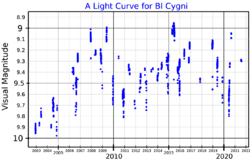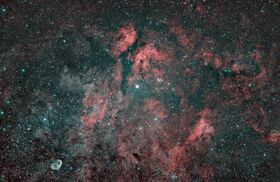Astronomy:BI Cygni
| Observation data Equinox J2000.0]] (ICRS) | |
|---|---|
| Constellation | Cygnus |
| Right ascension | 20h 21m 21.8869s[1] |
| Declination | 36° 55′ 55.729″[1] |
| Apparent magnitude (V) | 8.4 - 9.9[2] |
| Characteristics | |
| Spectral type | M4 Iab[2] |
| Variable type | Lc[2] |
| Astrometry | |
| Proper motion (μ) | RA: −2.751[1] mas/yr Dec.: −5.459[1] mas/yr |
| Parallax (π) | 0.3541 ± 0.0377[1] mas |
| Distance | 2,579+232 −226[3] pc |
| Absolute magnitude (MV) | −6.78[4] |
| Details | |
| Mass | 6.3[5] M☉ |
| Radius | 797[6] R☉ |
| Luminosity | 64,000 - 67,000[7] L☉ |
| Surface gravity (log g) | -0.35[5] cgs |
| Temperature | 3,550±170[7] K |
| Metallicity [Fe/H] | +0.40[5] dex |
| 2016 (maximum) | |
| Radius | 908+12 −10[8] R☉ |
| 2015 (minimum) | |
| Radius | 852+12 −9[8] R☉ |
| Other designations | |
| Database references | |
| SIMBAD | data |
BI Cygni (BI Cyg, IRC +40408, BD+36 4025) is a red supergiant in the constellation Cygnus. It is an irregular variable star with a maximum brightness of magnitude 8.4 and a minimum of magnitude 9.9. It is considered a member of the stellar Cygnus OB1 association,[4] its distance is around 2,600 parsecs (8,500 ly) of the Solar System. It is less than a degree south of another variable red supergiant, BC Cygni.

BI Cyg is a slow irregular variable star classified as type Lc, an irregular supergiant. Its brightness changes between extremes of magnitude 8.4 and 9.9.[2] Frequency analysis of its light curve shows no significant periods.[10]
BI Cyg is one of the largest known stars with a radius around 1,240 R☉ based on the assumption of an effective temperature of 3,575 K and a bolometric luminosity of 226,000 L☉.[4] More recent studies derive lower luminosities below 130,000 L☉, suggesting an initial mass of 20 M☉, and consequently lower values for the radius.[11][12][7]
See also
References
- ↑ 1.0 1.1 1.2 1.3 1.4 Vallenari, A. et al. (2022). "Gaia Data Release 3. Summary of the content and survey properties". Astronomy & Astrophysics. doi:10.1051/0004-6361/202243940 Gaia DR3 record for this source at VizieR.
- ↑ 2.0 2.1 2.2 2.3 Samus, N. N. et al. (2009). "VizieR Online Data Catalog: General Catalogue of Variable Stars (Samus+ 2007-2013)". VizieR On-line Data Catalog: B/GCVS. Originally Published in: 2009yCat....102025S 1. Bibcode: 2009yCat....102025S.
- ↑ Bailer-Jones, C. A. L.; Rybizki, J.; Fouesneau, M.; Demleitner, M.; Andrae, R. (2021). "Estimating Distances from Parallaxes. V. Geometric and Photogeometric Distances to 1.47 Billion Stars in Gaia Early Data Release 3". The Astronomical Journal 161 (3): 147. doi:10.3847/1538-3881/abd806. Bibcode: 2021AJ....161..147B.
- ↑ 4.0 4.1 4.2 Table 4 in Levesque, Emily M.; Massey, Philip; Olsen, K. A. G.; Plez, Bertrand; Josselin, Eric; Maeder, Andre; Meynet, Georges (August 2005). "The Effective Temperature Scale of Galactic Red Supergiants: Cool, but Not As Cool As We Thought". The Astrophysical Journal 628 (2): 973–985. doi:10.1086/430901. Bibcode: 2005ApJ...628..973L.
- ↑ 5.0 5.1 5.2 Anders, F.; Khalatyan, A.; Chiappini, C.; Queiroz, A. B.; Santiago, B. X.; Jordi, C.; Girardi, L.; Brown, A. G. A. et al. (2019). "Photo-astrometric distances, extinctions, and astrophysical parameters for Gaia DR2 stars brighter than G = 18". Astronomy and Astrophysics 628: A94. doi:10.1051/0004-6361/201935765. Bibcode: 2019A&A...628A..94A.
- ↑ Comerón, F.; Djupvik, A. A.; Schneider, N.; Pasquali, A. (October 2020). "The historical record of massive star formation in Cygnus". Astronomy & Astrophysics 2009: A62. doi:10.1051/0004-6361/202039188. Bibcode: 2020A&A...644A..62C.
- ↑ 7.0 7.1 7.2 Messineo, M.; Brown, A. G. A. (2019). "A Catalog of Known Galactic K-M Stars of Class I Candidate Red Supergiants in Gaia DR2". The Astronomical Journal 158 (1): 20. doi:10.3847/1538-3881/ab1cbd. Bibcode: 2019AJ....158...20M.
- ↑ 8.0 8.1 Norris, Ryan P. (2019). Seeing Stars Like Never Before: A Long-term Interferometric Imaging Survey of Red Supergiants (PDF) (PhD). Georgia State University.
- ↑ "OMC Archive". The Astronomical Data Centre at CAB. https://sdc.cab.inta-csic.es/omc/secure/form_busqueda.jsp?resetForm=true.
- ↑ Kiss, L. L; Szabó, Gy. M; Bedding, T. R (2006). "Variability in red supergiant stars: Pulsations, long secondary periods and convection noise". Monthly Notices of the Royal Astronomical Society 372 (4): 1721–1734. doi:10.1111/j.1365-2966.2006.10973.x. Bibcode: 2006MNRAS.372.1721K.
- ↑ Nicolas Mauron; Eric Josselin (2010). "The mass-loss rates of red supergiants and the de Jager prescription". Astronomy and Astrophysics 526: A156. doi:10.1051/0004-6361/201013993. Bibcode: 2011A&A...526A.156M.
- ↑ Josselin, E.; Plez, B. (2007). "Atmospheric dynamics and the mass loss process in red supergiant stars". Astronomy and Astrophysics 469 (2): 671–680. doi:10.1051/0004-6361:20066353. Bibcode: 2007A&A...469..671J.
External links
 |


